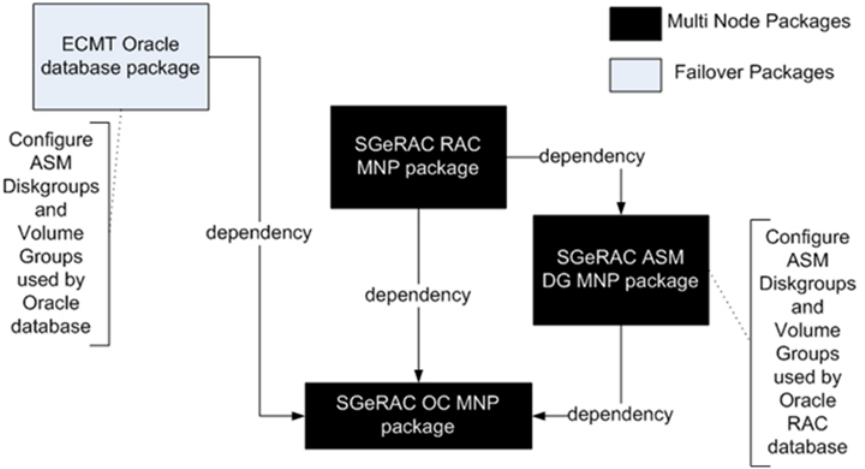HP Serviceguard Enterprise Cluster Master Toolkit User Guide (5900-2145, April 2013)
Table Of Contents
- HP Serviceguard Enterprise Cluster Master Toolkit User Guide
- Contents
- 1 Introduction
- 2 Using the Oracle Toolkit in an HP Serviceguard Cluster
- Overview
- Supported Versions
- Support for Oracle Database Without ASM
- Supporting Oracle ASM Instance and Oracle Database with ASM
- What is Automatic Storage Management (ASM)?
- Why ASM over LVM?
- Configuring LVM Volume Groups for ASM Disk Groups
- Sample command sequence for configuring LVM Volume Groups
- Serviceguard support for ASM on HP-UX 11i v3 onwards
- Framework for ASM support with Serviceguard
- Installing, Configuring, and Troubleshooting
- Setting up DB instance and ASM instance
- Setting up the Toolkit
- ASM Package Configuration Example
- Modifying a Legacy Database Package Using an Older Version of Oracle ECMT Scripts to use the Scripts Provided for ASM Support
- Adding the Package to the Cluster
- Node-specific Configuration
- Error Handling
- Network Configuration
- Database Maintenance
- Configuring and packaging Oracle single-instance database to co-exist with SGeRAC packages
- Configuring Oracle single-instance database that uses ASM in a Coexistence Environment
- Attributes newly added to ECMT Oracle toolkit
- Configuring a modular failover package for an Oracle database using ASM in a coexistence environment
- Configuring a legacy failover package for an Oracle database using ASM in a Coexistence Environment
- ECMT Oracle Toolkit Maintenance Mode
- Supporting EBS database Tier
- Oracle ASM Support for EBS DB Tier
- 3 Using the Sybase ASE Toolkit in a Serviceguard Cluster on HP-UX
- Overview
- Sybase Information
- Setting up the Application
- Setting up the Toolkit
- Sybase Package Configuration Example
- Creating the Serviceguard package using Modular method
- Adding the Package to the Cluster
- Node-specific Configuration
- Error-Handling
- Network configuration
- Database Maintenance
- Cluster Verification for Sybase ASE Toolkit
- 4 Using the DB2 Database Toolkit in a Serviceguard Cluster in HP-UX
- 5 Using MySQL Toolkit in a HP Serviceguard Cluster
- MySQL Package Configuration Overview
- Setting Up the Database Server Application
- Setting up MySQL with the Toolkit
- Package Configuration File and Control Script
- Creating Serviceguard Package Using Modular Method
- Applying the Configuration and Running the Package
- Database Maintenance
- Guidelines to Start Using MySQL Toolkit
- 6 Using an Apache Toolkit in a HP Serviceguard Cluster
- 7 Using Tomcat Toolkit in a HP Serviceguard Cluster
- Tomcat Package Configuration Overview
- Multiple Tomcat Instances Configuration
- Configuring the Tomcat Server with Serviceguard
- Setting up the Package
- Creating Serviceguard Package Using Modular Method
- Setting up the Toolkit
- Error Handling
- Tomcat Server Maintenance
- Configuring Apache Web Server with Tomcat in a Single Package
- 8 Using SAMBA Toolkit in a Serviceguard Cluster
- 9 Using HP Serviceguard Toolkit for EnterpriseDB PPAS in an HP Serviceguard Cluster
- 10 Support and Other resources
- 11 Acronyms and Abbreviations
- Index

Attributes newly added to ECMT Oracle toolkit
The following attributes are added to ECMT Oracle toolkit. These attributes must be populated only
for coexistence in an SGeRAC cluster. When there are no SGeRAC packages configured in the
same cluster, these attributes must be left empty.
• ORA_CRS_HOME: When using ECMT oracle toolkit in a coexistence environment, this attribute
must be set to Oracle CRS HOME.
• OC_TKIT_DIR: When using ECMT Oracle in a coexistence environment, this attribute must be
set to the SGeRAC Toolkit’s Oracle Clusterware (OC) package directory.
Figure 7 describes the various package dependencies between the single-instance Oracle database
package created using ECMT and the Oracle RAC packages created using SGeRAC.
Figure 7 Packages in a coexistence environment
Configuring a modular failover package for an Oracle database using ASM in a
coexistence environment
To configure an ECMT modular failover package for an Oracle database:
1. Log in as the Oracle administrator and run the following command to set the database
management policy to manual:
$ORACLE_HOME/bin/srvctl modify database -d <dbname> -y MANUAL
2. Create a database package directory under /etc/cmcluster
Log in as root:
# mkdir /etc/cmcluster/db1_package
3. Create the modular package configuration file "pkg2.conf”:
#cmmakepkg -m ecmt/oracle/oracle pkg2.conf
4. Configure the package attributes:
package_name - Set to any name desired.
package_type - Set to "failover".
Edit the service parameters if necessary. The service parameters are preset to:
service_name oracle_service
service_cmd "$SGCONF/scripts/ecmt/oracle/tkit_module.sh oracle_monitor"
service_restart none
service_fail_fast_enabled no
service_halt_timeout 300
58 Using the Oracle Toolkit in an HP Serviceguard Cluster










